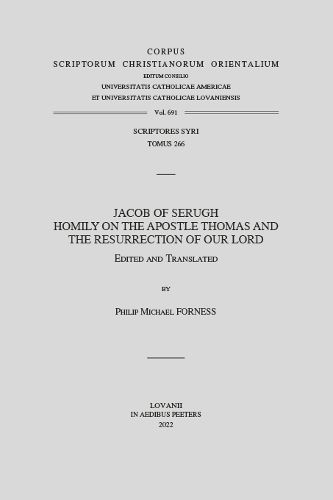Readings Newsletter
Become a Readings Member to make your shopping experience even easier.
Sign in or sign up for free!
You’re not far away from qualifying for FREE standard shipping within Australia
You’ve qualified for FREE standard shipping within Australia
The cart is loading…






This volume offers a critical edition and translation of Jacob of
Serugh’s Homily on the Apostle Thomas and the Resurrection of Our
Lord that focuses on John 20:19-28. The introduction describes the
twenty-nine manuscripts that preserve the homily, details the
construction of a stemma, presents case studies of editorial decisions
based on neo-Lachmannian principles, and explains the systems of
punctuation, orthography, and diacritical points. It also draws
attention to the reception of the homily by attending to the producers
and users of the manuscripts as well as the homily’s transmission in
exegetical, liturgical, and hagiographical collections. The apparatus
and appendices highlight paratextual marginalia, excerpts of the homily
in the Syriac Masora, the incorporation of the homily into a
liturgical rite, additions to the homily, and section divisions in
manuscript witnesses. Overall, the volume seeks to navigate between
employing a neo-Lachmannian editorial praxis and addressing the
interests of material philology.
$9.00 standard shipping within Australia
FREE standard shipping within Australia for orders over $100.00
Express & International shipping calculated at checkout
This volume offers a critical edition and translation of Jacob of
Serugh’s Homily on the Apostle Thomas and the Resurrection of Our
Lord that focuses on John 20:19-28. The introduction describes the
twenty-nine manuscripts that preserve the homily, details the
construction of a stemma, presents case studies of editorial decisions
based on neo-Lachmannian principles, and explains the systems of
punctuation, orthography, and diacritical points. It also draws
attention to the reception of the homily by attending to the producers
and users of the manuscripts as well as the homily’s transmission in
exegetical, liturgical, and hagiographical collections. The apparatus
and appendices highlight paratextual marginalia, excerpts of the homily
in the Syriac Masora, the incorporation of the homily into a
liturgical rite, additions to the homily, and section divisions in
manuscript witnesses. Overall, the volume seeks to navigate between
employing a neo-Lachmannian editorial praxis and addressing the
interests of material philology.